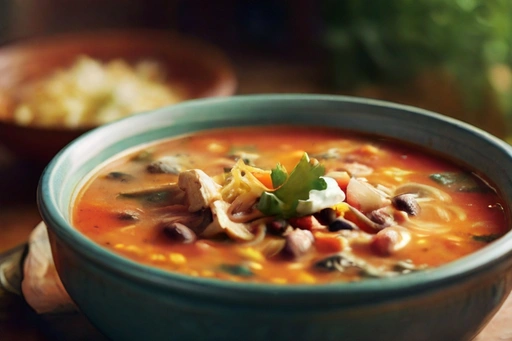
Introduction to Santa Fe Soup
Introduction to Santa Fe Soup
Ah, Santa Fe Soup! It’s more than just a dish; it’s a culinary journey that tantalizes your taste buds with its rich, southwestern flavors. This soup, a beloved staple in many households, is a symphony of ingredients that come together to create a hearty and comforting meal.
The Popularity and Origin of Santa Fe Soup
Originating from the heart of Southwestern cuisine, Santa Fe Soup has gained immense popularity, not just in its native New Mexico but across the United States. Its roots are deeply embedded in the fusion of Native American and Spanish flavors, a testament to the cultural melting pot that is Santa Fe. The soup’s unique blend of spices and ingredients reflects the vibrant and diverse culinary landscape of the region.
Overview of Santa Fe Soup Ingredients
At its core, Santa Fe Soup is a celebration of simplicity and flavor. The traditional recipe calls for ground beef or turkey, onions, tomatoes, beans, and corn, all simmered to perfection with a blend of spices like cumin and chili powder. This delightful mix not only offers a burst of flavor but also ensures a nutritious meal packed with protein and fiber.
But wait, there’s more! The beauty of Santa Fe Soup lies in its versatility. Whether you’re a meat-lover or a vegetarian, this soup can be tailored to suit your palate. You can explore various hearty soup recipes and healthy soup options, making it a perfect fit for any diet.
Recipe Variations
Diverse Recipes of Santa Fe Soup
Santa Fe Soup is like a canvas, offering endless possibilities to paint with flavors and ingredients. Whether you’re a traditionalist or an adventurous cook, there’s a version of this soup that’s just right for you.
Traditional Santa Fe Soup Recipe
Let’s start with the classic! The traditional Santa Fe Soup is a hearty blend of ground beef (or turkey), onions, tomatoes, a variety of beans, and corn. These ingredients are simmered in a rich broth seasoned with cumin, chili powder, and other Tex-Mex flavors. It’s a simple yet satisfying dish that warms the soul. For an authentic touch, try adding a packet of Hidden Valley Ranch dressing mix – a secret ingredient that adds a unique twist to the flavor profile.
Vegetarian and Vegan Alternatives
For our plant-based friends, fear not! The Santa Fe Soup easily transforms into a vegetarian or vegan delight. Swap the meat for quinoa or extra beans to amp up the protein content. You can also experiment with different types of vegetables like bell peppers and zucchini to add more healthy soup options to your diet. The key is to maintain the balance of spices to keep that signature Southwestern zest alive.
Low-Carb and Keto-Friendly Versions
If you’re watching your carb intake, Santa Fe Soup can still be on your menu. Replace high-carb beans and corn with low-carb veggies like cauliflower and spinach. You can also increase the meat content for added protein, making it a perfect fit for a keto diet. These easy family dinners are not only delicious but also ensure you stick to your dietary goals without compromising on taste.
Cooking Techniques for Perfect Santa Fe Soup
Cooking Techniques for Perfect Santa Fe Soup
Mastering the art of making Santa Fe Soup is a breeze, whether you’re a seasoned chef or a kitchen newbie. The key lies in the cooking technique you choose. Let’s explore the two most popular methods: the slow cooker and the stovetop.
Slow Cooker Method
The slow cooker is a fantastic tool for those who love the idea of ‘set it and forget it.’ To make Santa Fe Soup in a slow cooker, simply brown your meat (if using), then toss in all the ingredients, including the beans, corn, tomatoes, and spices. Set your slow cooker on low and let it work its magic for about 6-8 hours. The slow cooking process allows the flavors to meld beautifully, creating a depth of taste that’s hard to beat. Plus, it’s a great way to have a warm, welcoming meal ready at the end of a long day. For more tips on slow cooker meals, check out Serious Eats – “Mastering Slow Cooker Recipes”.
Stovetop Preparation
If you’re short on time, the stovetop method is your best friend. Start by cooking the meat and onions until they’re nicely browned. Then, add the remaining ingredients and bring the soup to a boil. Once boiling, reduce the heat and let it simmer for about 30 minutes. This method is quicker than the slow cooker and still yields a flavorful soup that’s sure to please. It’s perfect for those evenings when you want a comforting meal without the wait.
Nutritional Information
Nutritional Profile of Santa Fe Soup
When indulging in the rich flavors of Santa Fe Soup, it’s also important to consider its nutritional impact. This soup can be a wholesome addition to your diet, packed with essential nutrients, depending on how you prepare it.
Caloric Content and Macronutrients
A typical serving of Santa Fe Soup, especially when made with lean ground beef or turkey, is relatively low in calories yet high in protein. This makes it an excellent choice for those looking to maintain or lose weight while still enjoying a fulfilling meal. The beans in the soup are a fantastic source of protein and fiber, contributing to a feeling of fullness and aiding in digestion. Moreover, if you’re mindful of your fat intake, opting for lean meats and reducing the amount of cheese or sour cream toppings can significantly lower the fat content.
Dietary Fiber and Vitamins
Santa Fe Soup is not just about tantalizing your taste buds; it’s also about nourishing your body. The variety of beans and vegetables like tomatoes and corn contribute a significant amount of dietary fiber, essential for a healthy digestive system. These ingredients are also rich in vitamins and minerals, such as Vitamin C from tomatoes and iron from beans, making the soup a nutritious choice for a balanced diet.
Serving Suggestions
Serving and Pairing Ideas for Santa Fe Soup
When it comes to serving Santa Fe Soup, the possibilities are endless. A side of cornbread or a crisp green salad can complement the soup’s rich flavors. For dessert, why not explore something sweet like a Chocolate Cake with Cream Cheese Frosting? This pairing balances the hearty soup with a touch of sweetness, making for a well-rounded meal.
Accompaniments and Side Dishes
A bowl of Santa Fe Soup is almost a complete meal in itself, but the right accompaniments can elevate it to a whole new level. Consider serving it with a side of warm, crusty bread or cornbread, perfect for soaking up the flavorful broth. A fresh green salad with a tangy dressing can add a refreshing contrast to the hearty soup. For a more filling option, you might pair it with a cheesy quesadilla or a soft flour tortilla, ideal for scooping up every last delicious bite.
Beverage Pairings
When it comes to beverages, you have a variety of options that can complement the rich flavors of the soup. A light, crisp beer or a glass of chilled white wine can balance the soup’s heartiness. For a non-alcoholic option, consider a cool, refreshing iced tea or a zesty lemonade. These beverages not only quench your thirst but also enhance the overall dining experience.
Storage and Reheating Tips
Storing and Reheating Santa Fe Soup
Santa Fe Soup is not just a delight to eat; it’s also a breeze to store and reheat. Whether you’re savoring leftovers or prepping meals for the week, these tips will ensure your soup stays as delicious as the day you made it.
Refrigeration and Freezing Tips
For short-term storage, Santa Fe Soup can be refrigerated for up to 3-4 days. Make sure to let the soup cool to room temperature before transferring it to an airtight container. This prevents condensation, which can affect the soup’s texture and flavor. If you’re looking to store the soup for a longer period, freezing is an excellent option. Freeze the soup in portion-sized containers or freezer bags for up to 2-3 months. Remember to leave some space at the top of the container as the soup will expand when frozen.
Best Practices for Reheating
When it’s time to reheat, you have a couple of options. If the soup is frozen, thaw it in the refrigerator overnight. For reheating, you can use either a stovetop or a microwave. On the stovetop, reheat the soup over medium heat, stirring occasionally, until it’s heated through. In the microwave, use a microwave-safe container and heat the soup in intervals, stirring in between to ensure even heating. Avoid boiling the soup as it can break down the textures of the vegetables and beans.
Frequently Asked Questions About Santa Fe Soup
Frequently Asked Questions About Santa Fe Soup
Santa Fe Soup, with its rich flavors and versatile nature, often brings up a lot of questions. Let’s dive into some of the most commonly asked questions to help you perfect your soup-making and enjoying experience.
- Can I make Santa Fe Soup vegetarian or vegan? Absolutely! For a vegetarian version, simply omit the meat and add more beans, lentils, or even tofu for protein. For a vegan version, also ensure that any broth used is vegetable-based.
- What are the best toppings for Santa Fe Soup? Classic toppings include shredded cheese, sour cream, chopped green onions, and cilantro. For a healthier twist, try avocado slices or a dollop of Greek yogurt.
- How can I make my Santa Fe Soup spicier or milder? The spice level can be easily adjusted. For more heat, add diced jalapeños, cayenne pepper, or hot sauce. To keep it mild, use mild chili powder and opt for tomatoes without added chilies.
- Is Santa Fe Soup suitable for freezing? Yes, it freezes beautifully. Just remember to cool it completely before freezing and leave some space in the container for expansion.
- Can I use different types of beans in the soup? Definitely! Feel free to experiment with different beans like black beans, pinto beans, or even chickpeas for varied textures and flavors.
- What are some good side dishes to serve with Santa Fe Soup? A side of cornbread, a crisp green salad, or some tortilla chips are great accompaniments that complement the soup’s flavors.
- How can I thicken my Santa Fe Soup? If you prefer a thicker soup, you can mash some of the beans before adding them to the soup or add a cornstarch slurry (a mix of cornstarch and water) towards the end of cooking.
Conclusion
In conclusion, Santa Fe Soup stands out as more than just a meal; it’s a culinary adventure that embodies the spirit of Southwestern cuisine. Through this comprehensive exploration, we’ve delved into its origins, various recipes, cooking methods, nutritional value, and even the best ways to store and reheat it. We’ve also tackled some common FAQs, providing you with a well-rounded understanding of this versatile dish.
Whether you’re whipping up a traditional batch, experimenting with vegetarian or low-carb variations, or simply exploring new culinary horizons, Santa Fe Soup offers a unique blend of flavors and textures that cater to a wide array of tastes and dietary preferences. Its ease of preparation and heartwarming qualities make it an ideal choice for family dinners, casual gatherings, or a comforting meal on a chilly evening.
Remember, the beauty of Santa Fe Soup lies in its flexibility. Feel free to tweak the recipes to suit your taste buds, and don’t hesitate to explore the additional resources provided for more inspiration and guidance. Santa Fe Soup is not just food; it’s a celebration of culture, flavor, and the simple joys of cooking.
So, grab your pot and spices, and embark on this flavorful journey. Whether you’re a seasoned chef or a kitchen novice, Santa Fe Soup is sure to bring warmth, delight, and a taste of the Southwest right into your home. Happy cooking! 🍲🌶️🥄




